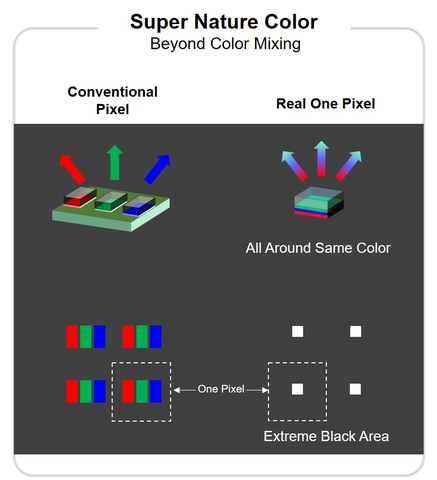Seoul Viosys demonstreert de ongeëvenaarde waarde van zijn micro-LED op IFA 2022
ANSAN, Zuid-Korea–(BUSINESS WIRE)– Seoul Viosys (“SVC”) (KOSDAQ: 092190), een fabrikant van optische halfgeleiderapparaten, zal micro-LED presenteren op basis van de gelamineerde structuur – die weergave met hoge resolutie mogelijk maakt – ook als zijn micro-LED-displayproducten op de IFA (Internationale Funkausstellung Berlin) 2022.
De door Seoul Viosys ontwikkelde gestapelde micro-LED heeft een unieke en innovatieve structuur waarin drie chips die rood, groen en blauw (R/G/B) vertegenwoordigen verticaal zijn gerangschikt in plaats van de gebruikelijke horizontale array. Het belangrijkste verschil met conventionele micro-LED’s is dat de R/G/B LED in de gestapelde structuur kleuren uitstraalt alsof ze een enkele pixel vormen door een perfecte kleurmenging.
Seoul Viosys to Demonstrate the Unparalleled Value of Its Micro-LED at IFA 2022
ANSAN, South Korea–(BUSINESS WIRE)– Seoul Viosys (“SVC”) (KOSDAQ: 092190), a manufacturer of optical semiconductor devices, will present micro-LED based on the laminated structure – which enables high-resolution display – as well as its micro-LED display products at the IFA (Internationale Funkausstellung Berlin) 2022.
This press release features multimedia. View the full release here: https://www.businesswire.com/news/home/20220902005087/en/

Remarkable color mixing technique developed based on Seoul Viosys’s unique technology (Graphic: Business Wire)
The stacked micro-LED developed by Seoul Viosys has a unique and innovative structure in which three chips representing red, green, and blue (R/G/B) are vertically arrayed instead of the usual horizontal array. Its main difference from conventional micro-LEDs is that its R/G/B LED in the stacked structure emit colors as if they constitute a single pixel through perfect color mixing.
Micro-LED produced by Seoul Viosys can achieve deep black color and clear image thanks to the stacked structure. Also, as colors combining R/G/B are emitted externally from inside a pixel, viewers can enjoy clear pictures without distortions from any direction.
The stacked micro-LED to be presented by Seoul Viosys at the exhibition is based on an innovative future technology that can manufacture 4K display screens between 100 and 200 inches. There will be a space where visitors can experience micro-LED in the company’s booth. It will show two micro-LED displays, including a 54-inch high-resolution 0.625mm pitch (P0.625) display and an 81.5-inch 0.9375mm pitch (P0.9375) display. Visitors will be able to enjoy highly immersive clear pictures wherein each pixel comes alive.
Various products representing key production processes of Seoul Viosys’s micro-LED, which have not been unveiled publicly, will also be on display. By exhibiting epitaxial wafers, cabinets, and other products fabricated using high-level transfer technology of moving micro-LED to a display substrate, the company will offer differentiated prices and quality while demonstrating its distinctive values.
In addition, Seoul Viosys will have an exhibition on its display LED techniques supporting its micro-LED technology, such as the molding technique that controls the moiré phenomenon and highlights the details of the black color, the low reflection technique that helps achieve vivid colors and high contrast ratios in the light, and the customized free form-factor design cabinet display that allows easy installation and replacement of microdisplay and change to various sizes.
As micro-LED has to run stably on extremely low power, it is difficult to achieve technological innovation without LED growth technology. Seoul Viosys already owns quantum efficiency enhancement technology for 1㎛-sized micro-LED through joint research with Nobel Laureate Shuji Nakamura, a professor at UC Santa Barbara, the U.S. The company also operates entire processes from the production of a red-green-blue light-emitting substrate to the manufacturing of devices and modules. Notably, WICOP, Seoul Viosys’s original technology, was applied to its micro-LED. WICOP is a key source technology that is necessary for producing micro-LED. It enables the fabrication of micro-scale chips by using no additional parts such as wires and has high reliability due to process simplification.
“By securing WICOP, a source technology for micro-LED and mini-LED, and quantum efficiency enhancement technology, Seoul Viosys is now ready to address any customer requests,” President Hwang Jeong-hwan of Seoul Viosys said. “Our micro-LED will enable the best image quality that viewers have never experienced before, and offer the top-notch solution in the rapidly changing large display market.”
He continued to say, “Seoul Viosys is introducing its products integrated for the purpose of providing a better solution to our customers, comprising LED, molding, and cabinet technologies, and demonstrating its competence,” once again stressing the company’s management principle of ‘no competition with customers.’
Seoul Viosys will introduce its Real One Pixel product that will be presented at the IFA 2022 on its social channels including YouTube (https://www.youtube.com/watch?v=kMJUzwxDqxk).
About Seoul Viosys
Seoul Viosys is a full-line solution provider for UV LED, VCSEL (Vertical Cavity Surface Emitting Laser), the next-generation light source for 3D sensor and laser, and a single-pixel RGB “Real One Pixel” for displays. Established in 2002 as a subsidiary of Seoul Semiconductor, it captured No. 1 market share in the UV LED industry (LEDinside, 2019). Seoul Viosys has an extensive UV LED portfolio with all wavelengths ranging from 200nm to 1600nm, including ultraviolet rays (UV), visible rays, and infrared rays. The company holds more than 4,000 patents related to UV LED technology. Violeds, its flagship UV LED technology, provides a wide range of industries with optimal solutions for robust sterilization and disinfection (UV-C), skin regeneration (UV-B), water/air purification and effective cultivation for horticulture. In 2018, Seoul Viosys acquired RayCan, a leading optoelectronic specialist, to add advanced VCSEL technology, which supports smartphone facial recognition and autonomous driving, and has started mass production. In January 2020, it introduced a disruptive “Real One Pixel” that has the potential to be a game-changer in the display market. To learn more, visit http://www.seoulviosys.com/en/.
View source version on businesswire.com: https://www.businesswire.com/news/home/20220902005087/en/
Contacts
Seoul Semiconductor Co., Ltd.
Jinseop Jung
Tel: +82-70-4391-8555
Email: jjs8732@seoulsemicon.com

